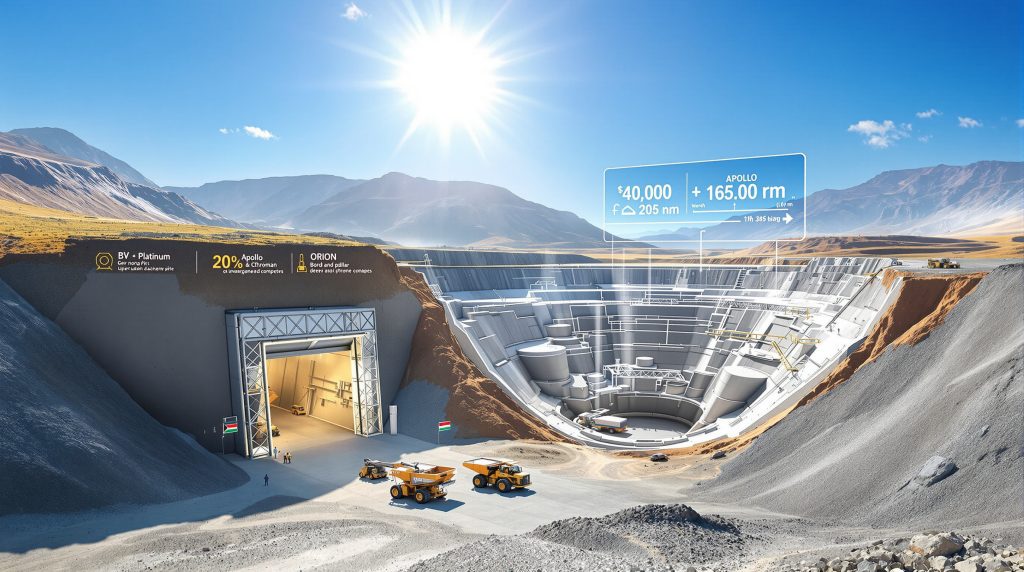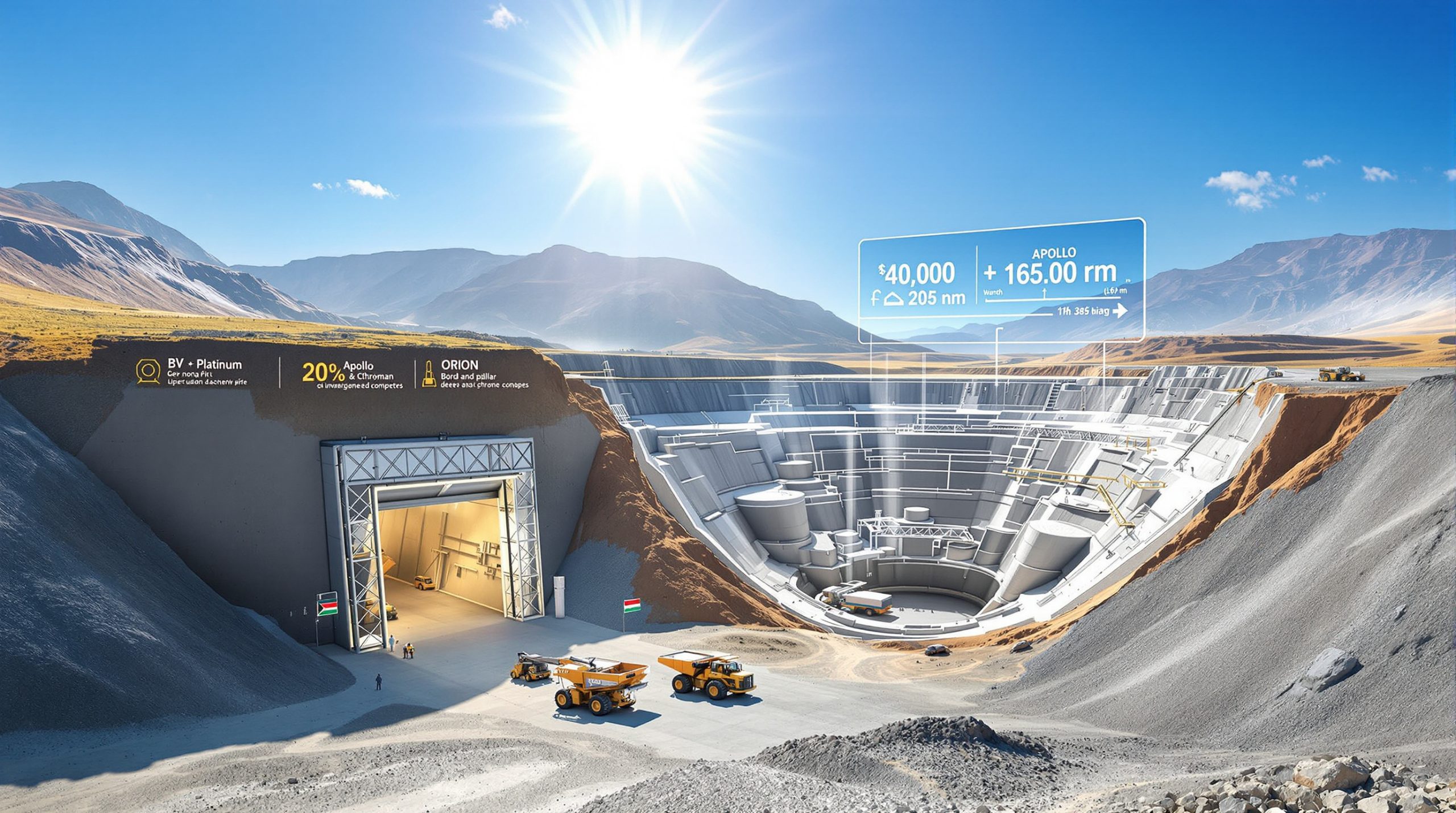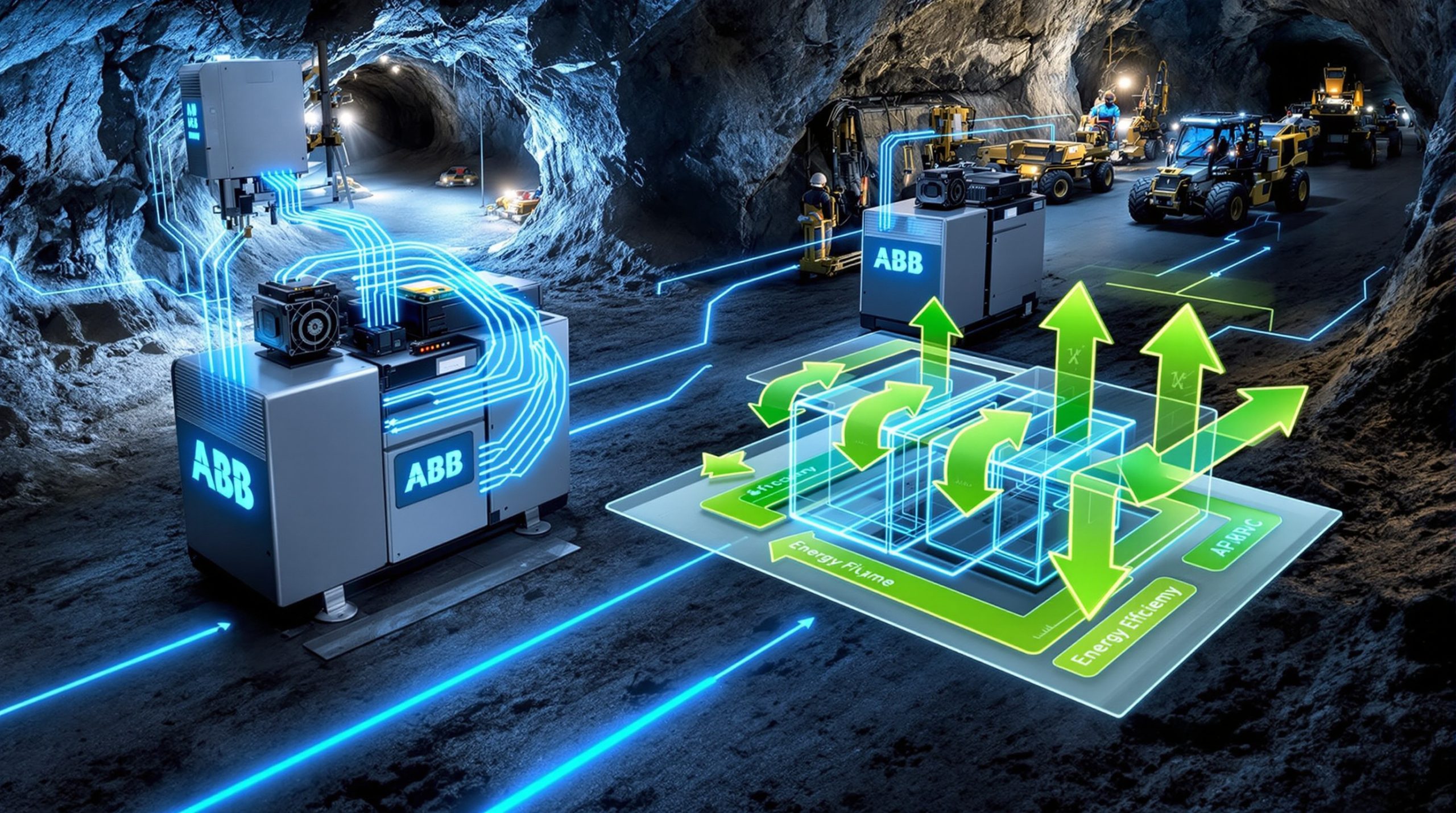Tharisa Mine's Strategic Transition to Underground Mining: A Sustainability Milestone
The transition of Tharisa Mine from open-pit to underground mining operations represents a landmark development in sustainable mining practices. This strategic shift reflects the natural evolution of mine lifecycle management while positioning the company for long-term operational viability. By implementing this carefully planned transition, Tharisa aims to maintain production levels while significantly reducing its environmental footprint and accessing deeper mineral reserves.
Why is Tharisa Mine Transitioning to Underground Operations?
Tharisa Mine's strategic transition to underground mining operations stems from a forward-thinking approach to resource management and operational sustainability. This shift represents more than just a technical mining decision—it embodies a comprehensive strategy to ensure the mine's long-term viability while addressing environmental concerns and maximizing resource extraction.
The transition addresses a fundamental challenge faced by mature open-pit operations: accessing deeper mineral reserves that extend beyond practical open-pit mining depths. Rather than continuing lateral expansion of the open pit—which would require significant additional land disturbance—Tharisa has opted for vertical development through underground mining techniques.
The Business Case for Underground Mining
The underground mining transition at Tharisa is supported by compelling business factors that align economic objectives with sustainability principles:
-
Resource Maximization: Underground operations enable access to extensive mineral deposits located beneath and adjacent to the open pit that would otherwise remain inaccessible. These multigenerational deposits contain significant quantities of platinum group metals and chrome concentrates essential to Tharisa's business model.
-
Extended Mine Life: While typical open-pit operations have finite lifespans constrained by practical depth limitations, Tharisa's underground development extends operational viability by more than 50 years. This provides exceptional business continuity and long-term planning horizons uncommon in the mining sector.
-
Reduced Environmental Impact: Underground mining substantially reduces surface disturbance compared to continued open-pit expansion. This aligns with growing regulatory pressures and stakeholder expectations for reduced ecological footprints from mining operations.
-
Operational Efficiency: Modern underground mining techniques allow for more selective extraction, potentially improving ore grade consistency while reducing waste material handling requirements. The transition to on-reef mechanized development delivers cleaner run-of-mine material with significantly less waste.
This strategic pivot represents a multigenerational commitment to sustainable resource development while maintaining Tharisa's position as a key supplier of critical minerals. The business case balances immediate capital requirements against decades of future production potential, creating a framework for long-term value creation.
What Timeline Will Guide Tharisa's Underground Transition?
The transition from open-pit to underground mining at Tharisa follows a carefully structured timeline designed to ensure production continuity while managing capital deployment effectively. This phased approach minimizes operational disruption and allows for systematic development of underground infrastructure.
Key Milestones in the Transition Process
The transition timeline encompasses several critical milestones that will mark Tharisa's evolution to a fully underground operation:
-
Q2 2026: First underground ore delivery expected, initiating the production ramp-up phase
-
2031: Apollo Complex (West Mine) and Orion Complex (East Mine) begin contributing significant volumes of mined ore to the processing stream
-
2035: Projected completion of open-pit mining operations, representing the culmination of surface extraction activities
-
Post-2035: Full transition to underground mining completed, with processing facilities entirely supplied by underground sources while maintaining the 5.6 million tonnes per annum capacity
This timeline allows for a gradual shift from surface to underground production, ensuring business continuity throughout the transition period. The overlap between open-pit and underground operations from 2026 to 2035 creates a buffer against potential delays or technical challenges in underground development.
Phased Development Approach
Tharisa has adopted a strategic portal development sequence that optimizes capital deployment while accelerating access to productive ore zones:
-
Early Portal Development: Initial portal construction provides access points to the ore body while underground infrastructure is established
-
Progressive Mining Front Expansion: Systematic development of mining fronts moving outward from initial access points
-
Infrastructure Establishment: Concurrent development of ventilation, power distribution, and material handling systems to support expanding underground operations
-
Contractor Partnership Model: Deployment of specialized mining contractors to support efficient transition operations
This phased approach allows Tharisa to leverage existing surface processing infrastructure while gradually transitioning underground. The sequence optimizes cash flow by generating revenue from early production zones while continuing development of future mining areas, creating a self-sustaining development model.
How Will Underground Mining Enhance Sustainability?
The shift to underground operations aligns with global mining industry evolution toward more sustainable resource extraction methods. This transition represents a significant advancement in Tharisa's environmental stewardship practices while maintaining production capabilities.
Environmental Benefits of the Transition
Underground mining delivers multiple environmental advantages compared to continued open-pit expansion:
-
Smaller Surface Footprint: Underground operations require significantly less surface disturbance than equivalent open-pit production, preserving natural landscapes and reducing habitat fragmentation
-
Cleaner Run-of-Mine Material: On-reef mechanized development delivers higher-grade material with substantially less waste rock, reducing processing requirements and waste management solutions
-
Reduced Waste Production: More precise extraction methods enable targeted ore recovery with minimized overburden and waste rock production
-
Lower Environmental Impact: Underground operations result in decreased visual impact, reduced dust generation, and simplified surface water management requirements
-
Reduced Land Rehabilitation Requirements: Smaller surface disturbance footprint means less land area requiring eventual mine reclamation innovations
These environmental improvements position Tharisa as an industry leader in sustainable mining practices while potentially reducing long-term environmental liabilities and compliance costs.
Operational Sustainability Improvements
Beyond environmental benefits, underground operations introduce operational sustainability advantages:
-
Mechanized Mining Methods: Implementation of modern equipment and techniques improves both efficiency and worker safety
-
Smart Mining Technologies: Digital integration enables real-time monitoring and optimization of mining processes, reducing resource waste and improving extraction efficiency
-
Reduced Energy Intensity: More targeted extraction methods potentially lower the energy required per tonne of processed material
-
Enhanced Worker Safety: Modern underground mining systems incorporate advanced safety features and monitoring capabilities that reduce workplace hazards
-
Weather-Independent Operations: Underground mining is less susceptible to weather-related disruptions, improving operational reliability
These operational improvements create a more resilient and sustainable business model capable of adapting to changing market conditions while maintaining productivity and safety standards.
What Production Capacity Will Be Maintained?
A key aspect of Tharisa's underground transition is the commitment to maintaining current production levels throughout and after the shift from open-pit operations. This ensures business continuity while leveraging existing processing infrastructure.
Processing Capacity and Production Targets
Tharisa's production framework provides clear parameters for the underground transition:
-
Current Processing Capacity: The existing facilities can process 5.6 million tonnes per annum (Mtpa) of run-of-mine material, establishing the upper limit for underground production targets
-
Target Underground Production: The Apollo and Orion complexes are designed to reach a combined production rate of 510,000 tonnes per month at steady state, precisely matching current processing capabilities
-
Product Focus: The transition maintains Tharisa's dual focus on platinum group metals (PGM) and chrome concentrates, preserving the company's established market position
-
Growth Potential: More selective underground mining methods may improve mineral recovery rates and concentrate grades, potentially enhancing product value even while maintaining tonnage throughput
This production framework ensures that Tharisa's market commitments remain unaffected during and after the transition, providing stability for customers and investors alike.
Mining Method and Efficiency
The underground mining approach has been designed for optimal efficiency within Tharisa's specific geological context:
-
Bord-and-Pillar Design: This proven mining method balances extraction rates with ground support requirements, creating a safe and cost-effective operational framework
-
On-Reef Mechanized Development: By developing directly within the mineral reef, Tharisa maximizes productive mining while minimizing waste rock handling
-
Contractor Model: Specialized mining contractors provide expertise and equipment for underground development, optimizing capital efficiency and bringing established operational experience
-
Selective Mining Potential: Underground methods enable more targeted extraction compared to bulk open-pit mining, potentially improving mineral recovery and reducing processing requirements
These methodological approaches support Tharisa's production targets while optimizing operational efficiency and resource recovery, ensuring that production capacity is maintained throughout the transition period.
What Financial Investment Does the Transition Require?
The underground transition represents a significant capital commitment structured to balance investment timing with operational cash flow. This approach minimizes financial risk while ensuring development proceeds at an optimal pace.
Capital Requirements and Funding Approach
Tharisa has developed a comprehensive financial framework for the underground transition:
-
Total Investment: The project requires US$547 million in capital over a ten-year development period, representing a substantial but measured commitment relative to the extended mine life gained
-
Peak Funding Requirement: Maximum capital intensity reaches US$173 million, creating a manageable funding threshold
-
Funding Sources: The development will be financed through a combination of internal cash resources generated from ongoing operations and external funding lines
-
Financial Strategy: Tharisa's approach utilizes balance sheet flexibility while maintaining financial discipline throughout the development cycle
This financial structure ensures the project remains economically viable while minimizing dilution risks for shareholders. The extended timeframe spreads capital requirements over multiple years, allowing operational cash flow to support a significant portion of development costs.
Return on Investment Considerations
The underground transition presents compelling return potential across multiple dimensions:
-
Multigenerational Resource Access: The capital investment unlocks decades of production potential, creating exceptional return longevity uncommon in mining investments
-
Operational Cost Efficiencies: Modern underground mining methods may reduce unit production costs through improved efficiency and reduced waste handling
-
Value Creation: The extended mine life enhances long-term shareholder value through sustainable operations beyond typical mining investment horizons
-
Risk Mitigation: The phased development approach reduces geological and operational risks by allowing progressive learning and adaptation as underground operations expand
This investment profile balances near-term capital requirements against exceptional long-term production potential, creating a financial model that supports sustainable business operations for generations to come.
How Does This Compare to Other Mining Transitions?
Tharisa's approach to underground transition incorporates industry best practices while adapting to the unique characteristics of its ore bodies and operational context. This tailored strategy optimizes transition efficiency while minimizing risks.
Industry Context and Comparative Analysis
Several factors position Tharisa's transition favorably compared to similar mining evolution projects:
-
Shallow Ore Body Advantage: Tharisa's relatively shallow deposits enable more cost-effective access compared to deeper underground transitions, reducing development timeframes and capital requirements
-
Modern Approach: Implementation of contemporary underground mining technologies and methods improves efficiency and safety compared to older transition projects
-
Phased Implementation: The gradual transition allowing operational learning and adjustment minimizes disruption risks common in abrupt operational shifts
-
Existing Infrastructure Leverage: Utilization of established processing facilities significantly reduces capital requirements compared to greenfield underground developments
These contextual advantages position Tharisa's underground transition as potentially more efficient and less risky than comparable projects in the global mining industry.
Innovative Elements of Tharisa's Approach
Beyond standard industry practices, Tharisa has incorporated several innovative elements in its transition strategy:
-
Co-Product Business Model: Maintaining dual focus on PGM and chrome production creates operational flexibility uncommon in single-commodity underground operations
-
Smart Mine Development: Future-proofing through digital integration establishes a foundation for ongoing efficiency improvements as technologies evolve
-
Flexible Mining Model: The adaptable approach allows operational adjustments based on changing market conditions, improving business resilience
-
Generational Planning: The 50+ year horizon extends beyond typical mining planning cycles, creating a truly multigenerational resource development framework
These innovative approaches differentiate Tharisa's underground transition from standard industry practices, potentially creating competitive advantages through improved operational flexibility and extended planning horizons.
What Leadership Perspective Guides This Transition?
The strategic vision for Tharisa's underground transition emanates from the highest levels of company leadership, reflecting a long-term commitment to operational excellence and value creation.
Executive Vision and Strategic Direction
Tharisa's leadership has articulated a clear vision for the underground transition that emphasizes sustainable growth and operational excellence:
According to Tharisa CEO Phoevos Pouroulis, the underground project represents the natural progression for operations and has been designed to access the multigenerational mineral resource base while enhancing operational efficiencies. The transition maintains world-class standards in health, safety, and environmental stewardship while further strengthening the company's track record of long-term value creation.
This executive perspective frames the underground transition as a natural evolution rather than a reactive measure, positioning it as part of a planned development sequence that maximizes resource potential while maintaining operational excellence.
Future-Focused Business Model
The leadership team has outlined a forward-looking business model that leverages the underground transition as a platform for sustained growth:
-
Modern Smart Mine Development: Integrating digital technologies and AI mining innovations to optimize operational performance
-
Future-Proofed Operational Capabilities: Designing systems with adaptability to evolving technologies and mining practices
-
More Efficient, Flexible Mining Model: Creating an operational framework that can adjust to changing market conditions and mineral characteristics
-
Multi-Generational Resource Access: Establishing a foundation for decades of sustainable production beyond typical planning horizons
This business model positions Tharisa for long-term success while creating flexibility to adapt to changing market conditions and technological advancements, ensuring continued relevance in a rapidly evolving global minerals market.
What Technical Approaches Will Support the Transition?
The underground mining plan incorporates specific technical elements designed to maximize efficiency and safety while minimizing costs and environmental impacts. These technical approaches form the operational foundation for Tharisa's transition strategy.
Mining Method Selection and Implementation
Tharisa has adopted technical approaches specifically suited to its geological context and operational objectives:
-
Bord-and-Pillar Design: This proven mining method creates a grid-like pattern of excavated "rooms" separated by "pillars" of unmined rock that provide natural roof support. This approach balances extraction efficiency with ground stability requirements.
-
Mechanized Mining: Modern underground equipment including continuous miners, shuttle cars, and roof bolters enable efficient extraction while enhancing worker safety through reduced direct exposure to mining faces.
-
Portal Development Strategy: Carefully positioned access tunnels provide efficient entry points to the ore body while optimizing ventilation and material handling requirements.
-
Infrastructure Integration: Underground systems connect seamlessly with existing surface facilities, reducing redundant infrastructure and optimizing material flow.
These technical approaches leverage proven mining methods while incorporating modern equipment and design principles to create a safe and efficient underground operation.
Technical Innovation and Efficiency
Beyond standard mining methods, Tharisa has incorporated technical innovations to enhance operational performance:
-
Reduced Capital Intensity: Technical approaches minimize upfront capital requirements through phased development and infrastructure optimization.
-
Improved Resource Recovery: Advanced geological modeling and selective mining techniques enhance resource recovery compared to bulk open-pit methods.
-
Operational Flexibility: Technical systems accommodate variable mining conditions and production requirements, improving adaptability to changing circumstances.
-
Risk Management: Engineering approaches incorporate redundancy and fail-safe elements to minimize operational and safety risks inherent in underground mining.
These technical innovations create a modern mining operation that balances efficiency with safety and environmental performance, establishing a sustainable technical foundation for decades of future production.
FAQ: Tharisa's Underground Mining Transition
How will the transition affect Tharisa's production volumes?
The transition is designed to maintain current production levels, with the underground operations scaled to match the existing processing capacity of 5.6 Mtpa. The phased approach ensures continuous production throughout the transition period, with the Apollo and Orion complexes together producing 510,000 tonnes per month at steady state—precisely matching plant processing capabilities.
What environmental benefits will result from underground mining?
Underground mining significantly reduces surface disturbance, decreases waste production, lowers dust generation, and minimizes visual impact compared to continued open-pit expansion. On-reef mechanized development delivers cleaner run-of-mine material with substantially less waste rock, reducing the overall environmental footprint of operations while maintaining production volumes.
How will the transition impact employment at Tharisa?
While specific employment figures haven't been disclosed, the transition will likely require workforce adaptation to underground mining skills, potentially creating opportunities for specialized roles in mechanized mining operations. The phased transition allows for gradual workforce training and skill development, potentially creating new career advancement pathways for existing employees.
What technologies will be implemented in the underground operations?
The underground mine will incorporate modern mechanized mining equipment including continuous miners, shuttle cars, and roof bolters alongside digital monitoring systems for ventilation, ground conditions, and equipment performance. Smart mining technologies will enable real-time operational monitoring and optimization, improving both efficiency and safety in underground environments.
How does this transition compare to similar projects globally?
Tharisa's transition benefits from relatively shallow ore bodies, enabling more cost-effective underground access compared to deeper deposits found in many global mining operations. The phased approach aligns with industry best practices for managing such transitions, while the existing processing infrastructure provides significant advantages over greenfield underground developments that require complete facility construction.
Table: Tharisa Underground Transition Key Metrics
| Metric | Value | Significance |
|---|---|---|
| Total Investment | US$547 million | Capital required over 10-year development |
| Peak Funding | US$173 million | Maximum capital requirement point |
| Processing Capacity | 5.6 Mtpa | Maintained throughout transition |
| Target Production Rate | 510,000 tonnes/month | Combined from Apollo and Orion complexes |
| Open-Pit Completion | 2035 | Projected end of open-pit operations |
| Extended Mine Life | 50+ years | Potential longevity from underground resources |
| First Underground Ore | Q2 2026 | Initial production milestone |
The Technical Evolution of Mining Methods
The transition to underground mining represents not just an operational shift but a technological evolution in Tharisa's mining approach. This technical transformation incorporates both proven methods and innovative applications designed for the specific characteristics of Tharisa's ore bodies.
Advanced Ground Control Systems
Underground stability is paramount for both safety and production efficiency. Tharisa's technical approach incorporates:
- Systematic Roof Bolting: Computer-modeled support patterns designed for specific rock conditions
- Real-Time Ground Monitoring: Sensors detecting subtle rock movements before they become hazardous
- Optimized Pillar Design: Engineering calculations balancing extraction rates with ground support requirements
These ground control systems enable safe extraction while maximizing ore recovery, ensuring both worker safety and resource utilization.
Ventilation and Environmental Management
Underground operations require sophisticated atmospheric control systems to maintain safe working conditions:
- Primary and Secondary Ventilation Circuits: Engineered airflow paths ensuring fresh air reaches all working areas
- Environmental Monitoring Networks: Real-time measurement of air quality, temperature, and gas concentrations
- Heat Management Systems: Controlling underground thermal conditions for equipment performance and worker comfort
These environmental management systems create sustainable underground working conditions while optimizing energy consumption for ventilation requirements.
Environmental Sustainability in Practice
Tharisa's underground transition implements practical sustainability measures that go beyond typical mining operations. These initiatives transform sustainability from concept to operational reality.
Water Management Innovations
Underground operations present distinct water management challenges and opportunities:
- Closed-Loop Water Systems: Recirculating process water to minimize consumption and discharge
- Underground Water Clarification: Settling and filtration systems reducing surface treatment requirements
- Strategic Dewatering: Controlled groundwater management preventing unnecessary pumping
These water management innovations reduce environmental impact while potentially lowering operational costs through reduced treatment and pumping requirements.
Energy Efficiency Measures
Underground mining traditionally requires significant energy inputs, making efficiency measures particularly valuable:
- Variable Speed Drive Systems: Optimizing equipment energy consumption based on actual requirements
- Load-Shifting Capabilities: Adjusting high-energy activities to off-peak periods
- Heat Recovery Systems: Capturing and repurposing thermal energy from underground operations
These energy efficiency measures reduce overall consumption while potentially improving the operation's carbon footprint compared to continued open-pit mining.
Future Market Implications
Tharisa's underground transition has significant implications for its market position and product offerings, potentially creating competitive advantages in evolving mineral markets.
Product Quality Enhancements
Underground mining methods may enable quality improvements in Tharisa's mineral products:
- More Consistent Ore Feed: Selective underground mining potentially delivering more homogeneous material to processing plants
- Reduced Dilution: Precision extraction techniques minimizing waste rock inclusion in run-of-mine material
- Grade Control Opportunities: Enhanced geological control enabling targeted extraction of higher-grade zones
These quality factors could strengthen Tharisa's market position while potentially commanding premium pricing for more consistent products.
Supply Chain Resilience
The underground transition enhances Tharisa's supply reliability for customers:
- Weather-Independent Operations: Underground mining less affected by seasonal weather patterns
- Extended Resource Security: 50+ year resource base providing exceptional supply assurance
- Production Flexibility: Underground methods allowing more responsive production adjustments to market demands
This supply chain resilience represents a significant competitive advantage in markets increasingly focused on reliable mineral sourcing from stable operations.
Disclaimer: This article contains forward-looking statements regarding mining operations, production targets, and financial projections. Actual results may vary from projections based on geological conditions, market factors, regulatory changes, and other variables beyond current knowledge or control. Readers should consider this information as general educational content rather than specific investment advice.
Ready to Stay Ahead of the Next Major Mineral Discovery?
Discovery Alert's proprietary Discovery IQ model instantly notifies investors of significant ASX mineral discoveries, turning complex data into actionable insights that can position you ahead of the market. Understand why historic discoveries generate substantial returns by visiting Discovery Alert's dedicated discoveries page.




